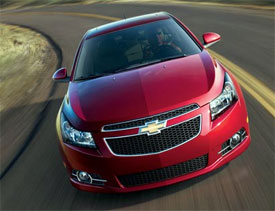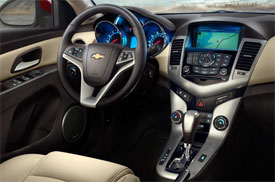2011 Chevrolet Cruze
For decades, Detroit’s automakers have been either unable or unwilling to sell world-class small cars in America. Too often their small cars were dumbed down to meet low cost and low expectations of a public that sees them only as basic transportation. Now, finally, we’re starting to see some of the great small cars Detroit builds for other countries come here. First it was the subcompact Ford Fiesta. And now it’s this car, the compact Chevrolet Cruze.
The 2011 Chevrolet Cruze is already sold in some 60 markets other than North America, where it plays the role not of commuter car, but of mainstream family sedan. So, while technically a compact, like the Cobalt before it, the Cruze is big for its ilk. At 181.0 inches in overall length, it’s six inches longer than a Toyota Corolla.
From its familiar two-tiered Chevy grille to its thickset back-end, the Cruze exudes a taut international profile and an overall look that’s substantial, but also very safe. Substantial too are Cruze wheels and tires with standard 16-inch and optional 17s and 18s.
The Cruze powertrain line-up will surprise many. Most trims are fitted with a trick 1.4-liter variable-timing, turbocharged I-4 rated at 138 horsepower and 148 pound-feet of torque. Only the base Cruze LS uses a non-turbo 1.8-liter ECOTEC with 138 horsepower and 123 pound-feet of torque.
 The LS and high mileage Cruze ECO models come with a standard six-speed manual, while others start and end with a six-speed manual-mode automatic.
The LS and high mileage Cruze ECO models come with a standard six-speed manual, while others start and end with a six-speed manual-mode automatic.
That provides Cruze with Government Fuel Economy ratings of 24 city/36 highway using regular gas. We saw a solid 31.5 in real-world driving. Cruze Energy Impact Score is a modest 12.2 barrels of oil consumed per year, with a smallish Carbon Footprint of 6.7 annual tons of CO2 emitted.
But hypermilers will be more interested in the Cruze ECO due later. With a slew of aero upgrades, it will bare a highway rating of 42, more than the smaller Ford Fiesta. There are even more surprises inside.
The interior of the Chevy Cruze is a real game changer. Not only is it very quiet, and near mid-size in roominess, the quality of materials is impressive. Instead of acres of hard plastics, you’ve got soft materials on the face of the dash and the doors. And over here, around the center console and the center stack, expensive-look ‘piano black’ accents. That’s not what I would expect to find in a moderately priced compact car.
This edition of Chevy’s cockpit interior theme is very handsome, although some felt slightly penned in by it. The easy scan motorcycle-like gauge cluster with trip computer screen fits well. Seats are comfortable, nicely bolstered, with good lower back support. Our 2LT trim added leather and heat. All Cruze models are well-equipped with air, six-speaker CD/XM-stereo, keyless entry, and lots of cupholders and storage options. And for safety, Cruze wears OnStar and an impressive 10 airbags, including two rear seat side bags.
The rear seat offers ample room for three, although leg room is less than we’d hoped. But fold the 60/40 seat backs and the trunk’s already huge 15 cubic feet of space grows exponentially. So it may be world-class in design, but does it drive that way too?
 With no notable turbo lag, initial throttle response is great. But, tall gearing bogs things down from there. Still, a 0-60 of 9.2 seconds is within expectations for an economy sedan. The quarter mile passed in a lazy 17.1 seconds at 82 miles per hour with mostly smooth shifts.
With no notable turbo lag, initial throttle response is great. But, tall gearing bogs things down from there. Still, a 0-60 of 9.2 seconds is within expectations for an economy sedan. The quarter mile passed in a lazy 17.1 seconds at 82 miles per hour with mostly smooth shifts.
High strength steel gives the Cruze a solid platform to mount a front strut, and rear torsion beam suspension. Engineers added a centering Watts Linkage, here called Z-Link, for added roll and lateral control. Traction and Stability Control are standard.
Surprise again, the Cruze scoots through the cones with the kind of agility you expect from a car designed for Europe and beyond. Understeer is moderate and consistent, with good steering feedback. The driver can actually concentrate on having a little fun. Overall, Cruze handling is safe and solid.
The Cruze is fitted with ABS front discs and rear drums standard, with all-disc an option. Our car’s disc/drum combo averaged an acceptable 129 feet from 60 to zero. Reaction was stable and the pedal reasonably firm. On normal roads, Cruze ride quality is also solid. It conveys the quietude of a premium-level vehicle. Cruze prices are higher than the outgoing Cobalt, but they’re still very reasonable. The Cruze LS starts at $16,995, the LT at $18,895, and the LTZ at $22,695.
The success of the 2011 Chevrolet Cruze is critical to GM’s long-term global prosperity. Fortunately, it beat all of our expectations, and then some. It’s a well-equipped, roomy, high quality, small car that should make even the most dyed-in-the-wool import buyers take a long and hard second look.
Specifications
- Engine: 1.4-Liter Variable-timing, Turbocharged I-4
- Horsepower: 138
- Torque: 148 Lb Feet
- 0-60 MPH: 9.2 Seconds
- 1/4 Mile: 17.1 Seconds @ 82 MPH
- 60-0 MPH: 129 Feet
- EPA: 24 MPG City/ 36 MPG Highway
- Mixed Loop: 31.5 MPG
- Energy Impact 12.2 Barrels Oil/Yr:
- CO2 Emissions: 6.7 Tons/Yr
2024 Polestar 2
More Range And More Power For The Polestar 2
Volvo is well on their way to making the transition to an all-electric brand, but their sister-brand Polestar is already there. Now, we’ve spent lots of time in their all-wheel drive, five-door Polestar 2, having tested it in 2021, and a year later when a two-wheel drive version arrived. But, EV updates are coming quickly. So, let us be your guide for all that’s new with the Polestar 2.
While we are driving more EVs than ever, we’ve also been spending a lot of time recently circling back to ones we’ve previously tested. As in this new era of electrified vehicles, significant updates are arriving quickly, with R&D investments increasing and retrofitting them easier than ever. This is often done through software updates that can even be accomplished over the air. For 2024, the Polestar 2 has indeed gotten some software updates, but some physical ones as well.
Clearly aimed directly at Tesla’s Model 3 when it arrived; the Polestar 2’s build quality was vastly better, but range definitely came up short. So, addressing that was priority No. 1; and for ’24 the Polestar can travel up to 20% farther than before while consuming 9% less energy, and when it comes time to charge it back up, it can do that 34% faster too.
Range in the Single Motor version increases from a max of 270 to 320 miles thanks to a larger 82-kWh battery pack, and that solitary motor now powers the rear wheels, not the front wheels. It’s also bigger, coming in at 220 kW compared to the previous 170 kW front-wheel drive version, going from 231 to 299 horsepower.
Dual Motors keep the same 78-kWh battery, but still sees a boost from 260 to 276 miles and takes advantage of the larger rear motor for a new combined 310-kW output with 421 horsepower. Our test car has the added Performance Pack, which uses an additional 35 kW to deliver 455 horsepower and 546 lb-ft of torque, though max range drops to just 247 miles.
The new battery in rear-drive 2s will also charge faster, now accepting up to 205 kW for an 80% charge in 20 minutes; max for dual-motors stays at 155 kW, which puts an 80% charge at 34 minutes. Using 32 kWh of electricity per 100 miles, the Dual Motor earns a good efficiency rating.
The [Polestar] 2 has always been one of the most enjoyable EVs to drive, even more so now with that additional power coming from the rear motor.
Unfortunately, extremely cold temperatures kept us from seeing that increased range, as we were only on pace for about 194 miles in our test.
The 2 has always been one of the most enjoyable EVs to drive, even more so now with that additional power coming from the rear motor. And especially when equipped with the Performance Pack as it not only includes more power, but adds 20-inch forged wheels, upgraded brakes, and adjustable Ohlins Dual Flow Valve performance dampers. It greatly improves handling prowess without affecting ride quality, and is easily worth the $5,500 charge if you at all enjoy driving.
Even on a 20-degree track day there was plenty of grip through our handling course. No understeer or oversteer, and lots of feedback through the wheel. There was a nice, strong launch off the line that properly planted us firmly in the seat, and rocketed us to 60 in 4.5 seconds. Power delivery stayed pretty intense up until about 80 mph when there was a definite tapering off. Still, it was a 13.4-second quarter-mile at 102 mph; smooth, quiet, and stable the whole way.
When this car debuted, its Google-based infotainment setup was a novelty, but since then, more and more manufacturers are just “Googling it” so it doesn’t seem out of place at all. The wireless phone charger is easy to access, and there’s a great Harmon/Kardon sound system and panoramic sunroof to enhance the in-cabin experience. Exteriors have also been enhanced with a smooth grille insert and new wheel choices.
Hatchback practicality means 14.3 cu-ft of easy to access cargo space with split-folding seatbacks for longer items and expanding the space to 38.7 cu-ft. Plus, there’s even a sizeable storage bin up front under the hood.
Single Motor Polestar 2 pricing now starts at $51,300, with Dual Motors starting at $56,700; topping out at $64,400.
For a car manufacturer that hasn’t even been around for a decade yet, Polestar has kept itself busy, totally transforming their latest model in just a few years, making the 2024 Polestar 2 even more appealing. They are certainly off to a good start, and with a host of Polestars just over the horizon, including some all-important utility vehicles, this star will be shining even brighter.
Specifications
As Tested
- Motor Setup: Dual Motor
- Horsepower: 455
- 0-60 mph: 4.5 seconds
- EPA Range: 247 miles
- Efficiency : 32 kWh / 100 miles
- Battery Size: 78-kWh
- Torque: 546 lb-ft
- 1/4 Mile: 13.4 seconds at 102 mph
- MW Test Loop: ~ 194 miles
- Peak Charging Rate: 155 kW











































